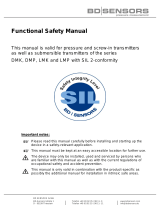
XNX Universal Transmitter
Proof Testing Procedure 7Checking
6 Proof Testing Procedure
6.1 Checking
The purpose of checking is to ensure the mA output meets the
expected levels. If the current does not meet the expected levels, it
will have to be adjusted. If, after completing 6.1.1, 6.1.2, and 6.1.3, the
mA output does meet the expected levels, proceed to 6.3.
6.1.1 Force mA Output
1. Ensure the current can be measured at the controller end.
The current will be measured using the procedures outlined
in 6.1.1 to 6.1.3.
2. From the Main Menu, select the Test Menu ( ).
CAUTION
The mA output set in this menu will revert to the normal operating
values when exiting the Test Menu. For more information on setting
the mA output levels for normal operation, see mA Levels in the XNX
Technical Manual.
3. From the Test Menu, select Force mA Output ( ).
The New mA Output screen shows the existing mA output in
the left column. The user can adjust the output by changing
the value in the column on the right.
Figure 1. New mA Output Screen
4. Ensure the current at the controller end is 4.0 mA. If the current
is not 4.0 mA, refer to 6.2.1 to adjust the output.
5. Repeat steps #2-4 to check the output of 20.0 mA.
6.1.2 Zero Gas mA Output
The procedure for zero gas is not applicable to the ECC O2 sensor.
1. Apply zero gas to the sensor.
2. The current at the controller end should be 4.0 mA.
If the mA output is not at the expected level when applying
zero gas, perform a Zero Gas Calibration. Refer to 6.2.2 and
complete the procedure for a Zero Gas Calibration.
6.1.3 Calibration Gas mA Output
1. Apply calibration gas to the sensor.
2. The current measured at the controller end is related to the
percentage of gas applied.
Example: 100% of full gas concentration is equivalent to
20.0 mA. If 75% of the full scale gas concentration is applied,
the mA output should be 16.0 mA.
If the mA output is not at the expected level when applying
calibration gas, refer to 6.2.2 and perform a Zero Gas Calibration
and a Span Gas Calibration.
6.2 Adjusting
Perform the following procedures if 4.0 mA and 20.0 mA were not
measured at the controller end. If the correct currents were measured,
proceed to 6.3.
The current must be measured at the controller end in 6.2.1 and 6.2.2.
6.2.1 Calibrate 4.0 mA and 20.0 mA
1. From the Main Menu, select the Test Menu ( ).
2. Then select Force mA output ( ).
3. Adjust the current output in the column on the right until the
current at the controller end is 4.0 mA.














